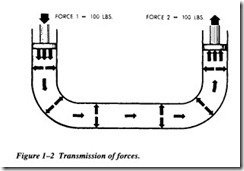USE OF HYDRAULICS
The hydraulic press, invented by Englishman John Brahmah, was one of the first workable machines that used hydraulics in its operation. It consisted of a plunger pump piped to a large cylinder and a ram. This press found wide use in England because it provided a more effective and economical means of applying large, uniform forces in industrial uses.
Today, hydraulic power is used to operate many different tools and mechanisms. In a garage, a mechanic raises the end of an automobile with a hydraulic jack. Dentists and
barbers use hydraulic power to lift and position their chairs. Hydraulic doorstops keep heavy doors from slamming. Hydraulic brakes have been standard equipment on automobiles since the 1930s. Most automobiles are equipped with automatic trans missions that are hydraulically operated. Power steering is another application of hydraulic power. Construction workers depend upon hydraulic power for their equip ment. For example, the blade of a bulldozer is normally operated by hydraulic power.
Operation of Hydraulic Components
To transmit and control power through pressurized fluids, an arrangement of interconnected components is required. Such an arrangement is commonly referred to as a system. The number and arrangement of the components vary from system to system, depending on the particular application. In many applications, one main system sup plies power to several subsystems, which are sometimes referred to as circuits. The complete system may be a small, compact unit or a large, complex system that has components located at widely separated points within the plant. The basic components of a hydraulic system are essentially the same, regardless of its complexity. These seven components, which must be in every hydraulic system, are as follows:
Reservoir or receiver. This is usually a closed tank or vessel that holds the volume of fluid required to support the system. The vessels normally provide several functions in addition to holding fluid reserves. The major functions include filtration of the fluid, heat dissipation, and water separation.
Hydraulic pump. This is the energy source for hydraulic systems. It converts electrical energy into dynamic, hydraulic pressure. In almost all cases, hydraulic systems utilize positive displacement pumps as their pri mary power source. These are broken down into two primary subclassifications: constant-volume or variable-volume. In the former, the pumps are designed to deliver a fixed output (i.e., both volume and pressure) of hydraulic fluid. In the latter, the pump delivers only the volume or pressure required for specific functions of the system or its components.
Control valves. The energy generated by the hydraulic pump must be directed and controlled so that the energy can be used. There are a variety of directional and functional control valves that are designed to provide a wide range of control functions.
Actuating devices. The energy within a hydraulic system is of no value until it is converted into work. Typically, this is accomplished by using an actuating device of some type. This actuating device may be a cylinder, which converts the hydraulic energy into linear mechanical force; a hydraulic motor, which converts energy into rotational force; or a variety of other actuators designed to provide specific work functions.
Relief valves. Most hydraulic systems use a positive displacement pump to generate energy within the system. Unless the pressure is controlled, these Basic Hydraulics 7
pumps will generate excessive pressure that can cause catastrophic failure of system components. A relief valve is always installed downstream of the hydraulic pump to prevent excessive pressure and to provide a positive relief should a problem develop within the system. The relief valve is designed to open at a preset system pressure. When the valve opens, it diverts flow to the receiver tank or reservoir.
Lines (pipe, tubing, or flexible hoses). All systems require some means to transmit hydraulic fluid from one component to another. The material of the connecting lines will vary from system to system or within the system.
Hydraulic fluid. The fluid provides the vehicle that transmits input power, such as from a hydraulic pump to the actuator device or devices that per form work.
